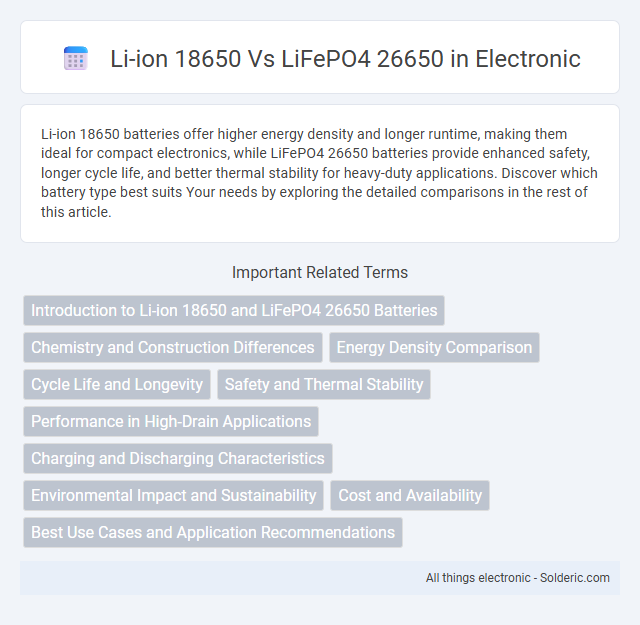Li-ion 18650 batteries offer higher energy density and longer runtime, making them ideal for compact electronics, while LiFePO4 26650 batteries provide enhanced safety, longer cycle life, and better thermal stability for heavy-duty applications. Discover which battery type best suits Your needs by exploring the detailed comparisons in the rest of this article.
Comparison Table
| Feature | Li-ion 18650 | LiFePO4 26650 |
|---|---|---|
| Battery Type | Lithium-ion | Lithium Iron Phosphate (LiFePO4) |
| Size (Diameter x Length) | 18mm x 65mm | 26mm x 65mm |
| Nominal Voltage | 3.6V - 3.7V | 3.2V - 3.3V |
| Capacity Range | 1800mAh - 3500mAh | 2000mAh - 5000mAh |
| Cycle Life | 300 - 500 cycles | 2000 - 4000 cycles |
| Energy Density | 150 - 250 Wh/kg | 90 - 120 Wh/kg |
| Weight | Approx. 45g | Approx. 70g |
| Safety | Moderate risk of thermal runaway | High thermal and chemical stability |
| Operating Temperature Range | -20degC to 60degC | -20degC to 60degC |
| Applications | Laptops, flashlights, electric vehicles | Electric vehicles, solar storage, power tools |
Introduction to Li-ion 18650 and LiFePO4 26650 Batteries
Li-ion 18650 batteries are cylindrical lithium-ion cells known for high energy density, making them ideal for portable electronics and electric vehicles. LiFePO4 26650 batteries offer enhanced thermal stability, longer cycle life, and safer chemistry, commonly used in energy storage and power tools. Your choice depends on whether you prioritize higher energy capacity with Li-ion 18650 or improved safety and durability with LiFePO4 26650 cells.
Chemistry and Construction Differences
Li-ion 18650 cells utilize a lithium cobalt oxide (LiCoO2) or similar chemistry with a cylindrical form factor measuring 18mm in diameter and 65mm in length, offering high energy density but requiring careful thermal management. LiFePO4 26650 batteries, larger at 26mm diameter and 65mm length, employ lithium iron phosphate chemistry, known for superior thermal stability, longer cycle life, and enhanced safety due to their stable olivine crystal structure. Construction-wise, 18650 cells often feature a layered electrode design optimized for energy capacity, while 26650 LiFePO4 cells have thicker electrodes and robust casings to support higher current output and durability.
Energy Density Comparison
Li-ion 18650 batteries typically offer higher energy densities, averaging around 250-300 Wh/kg, compared to LiFePO4 26650 cells, which usually range between 90-120 Wh/kg. The smaller 18650 format benefits from advanced lithium-cobalt oxide or nickel-cobalt-aluminum chemistries, delivering greater energy storage per unit weight. LiFePO4 chemistry prioritizes safety and longevity but sacrifices energy density, making 18650 cells more suitable for applications demanding compact, high-capacity power sources.
Cycle Life and Longevity
LiFePO4 26650 cells offer significantly longer cycle life, typically around 2000 to 3000 cycles, compared to Li-ion 18650 cells which range from 300 to 500 cycles. The inherent chemical stability of LiFePO4 results in enhanced longevity and more consistent capacity retention over time. This makes LiFePO4 26650 batteries a preferred choice for applications demanding extended service life and reliability.
Safety and Thermal Stability
LiFePO4 26650 batteries offer superior safety and thermal stability compared to Li-ion 18650 cells, as their chemistry resists thermal runaway and reduces the risk of fire or explosion under stress. Li-ion 18650 batteries deliver higher energy density but are more prone to overheating and thermal instability during rapid discharge or damage. When choosing a battery for applications where safety and thermal management are critical, your best option is the more robust and temperature-tolerant LiFePO4 26650 model.
Performance in High-Drain Applications
Li-ion 18650 batteries deliver higher energy density and voltage, making them ideal for high-drain applications requiring rapid discharge and longer runtime. LiFePO4 26650 cells offer superior thermal stability, longer cycle life, and enhanced safety, though with lower voltage and energy density compared to 18650 Li-ion batteries. For devices demanding consistent high current output and durability under stress, LiFePO4 26650 batteries excel despite their larger size and weight.
Charging and Discharging Characteristics
Li-ion 18650 cells offer higher energy density with faster charging capabilities, typically supporting charge rates up to 1C or higher, while delivering stable voltage under load but require precise charging control to prevent damage. LiFePO4 26650 batteries provide superior cycle life and enhanced thermal stability, allowing for higher discharge currents up to 3C or more and safer operation at elevated temperatures. For your application, choosing between these depends on the balance you need between energy density, charge speed, and long-term reliability in discharge performance.
Environmental Impact and Sustainability
Li-ion 18650 batteries generally have a higher energy density but rely on cobalt and nickel, which raise concerns about mining-related environmental damage and limited resource sustainability. LiFePO4 26650 batteries offer a more eco-friendly alternative with safer, non-toxic materials, longer lifespan, and better thermal stability, reducing the need for frequent replacements and lowering waste. Choosing LiFePO4 26650 cells contributes to a more sustainable energy solution by minimizing hazardous material usage and supporting battery recycling initiatives.
Cost and Availability
Li-ion 18650 batteries generally offer a lower upfront cost and wider availability due to their popularity in consumer electronics and electric vehicles, making them more accessible for various applications. LiFePO4 26650 cells tend to be more expensive and less readily available but provide longer cycle life and enhanced safety features, justifying the investment for specific uses like solar storage or heavy-duty power tools. Your choice should consider the balance between cost-effectiveness and long-term reliability based on the battery's intended application.
Best Use Cases and Application Recommendations
Li-ion 18650 batteries excel in high-drain devices like laptops, flashlights, and power tools due to their high energy density and compact size. LiFePO4 26650 cells provide superior thermal stability and longer cycle life, making them ideal for electric vehicles, solar energy storage systems, and heavy-duty industrial applications. Selecting between 18650 and 26650 depends on the priority of energy density versus safety and longevity for specific use cases.
Li-ion 18650 vs LiFePO4 26650 Infographic

 solderic.com
solderic.com